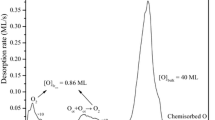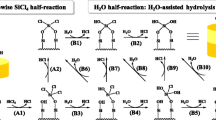Abstract
We present comprehensive first-principles calculations on the initial stages of SiC oxidation by atomic oxygen on the 2H-SiC(001) surface. In order to study the kinetics of oxygen incorporation at the 2H-SiC(001) surface, we investigated adsorption and diffusion of oxygen atoms and SiO2 nucleation. The adsorption sites, corresponding to the local minima of the potential energy surface (PES) for isolated adatoms, were identified through a comparative study of the adatom binding energy at different locations. We found that the Bridge (siloxane) site is preferred over other adsorption sites. There is no energy barrier at 0K for oxygen insertion into this site. The diffusion energy barriers that the adatom has to overcome when jumping between two adsorption sites were calculated. The premises of silica nucleation were investigated by calculating the modifications of the oxygen atom binding energy due to the interaction with neighboring adatoms.
Similar content being viewed by others
References
Bhatnagar M, Baliga B J. Comparison of 6H-SiC, 3C-SiC, and Si for power devices. IEEE Trans Electron Devices, 1993, 40(3): 645–655
Sheppard S T, Melloch M R, Cooper J AJr. Characteristics of inversion- channel and buried-channel MOS devices in 6H-SiC. IEEE Trans. Electron Devices, 1994, 40(7): 1257–1264
Cho W J, Kosugi R, et al. Study on electron trapping and interface states of various gate dielectric materials in 4H-SiC metal-oxide-semiconductor capacitors. Appl Phys Lett, 2000, 77(13): 2054–2056
Bermudez V M. Photoemission study of oxygen adsorption on (001) silicon carbide surfaces. J Appl Phys, 1989, 66(12): 6084–6092
Righi M C, Pignedoli C A, Felice R D, et al. Ab initio Simulations of homoepitaxial SiC growth. Phys Rev Lett, 2003, 91(13): 136101
Ventra M D, Pantelides S T. Atomic-scale mechanisms of oxygen precipitation and thin-film oxidation of SiC. Phys Rev Lett, 1999, 83(8): 1624–1627
Schmeißer D, Batchelor D R, Mikalo R P, et al. Oxide growth on SiC (0001) surfaces. Appl Surf Sci. 2001, 184(1–4): 340–345
Rauls E, Hajnal Z, Deák P, et al. Theoretical study of the nonpolar surfaces and their oxygen passivation in 4H- and 6H-SiC. Phys Rev B, 2001, 64(24): 245323
Jiang Z Y, Xu X H, Wu H S, et al. Ab initio calculation of SiC polytypes. Solid State Commun, 2002, 123(6): 263–266
Kawamura F, Ogura T, Imade M, et al, Growth of 2H-SiC single crystals in a Li-based flux. Mater Lett, 2008, 62(6–7): 1048–1051
Son N T, Kordina O, KonstantinovA O, et al. Growth of 2H-SiC single crystals in a Li-based flux. Appl Phys Lett, 1994, 65(25): 3209–3211
Virojanadara C, Johansson L I. Metastable oxygen adsorption on SiC (0001)- √3 × √3 R30°. Surf Sci, 2002, 519(1–2): 73–78
Amy F, Soukiassian P, Hwu Y K, et al. Si-rich 6H- and 4H-SiC(0001) 3×3 surface oxidation and initial SiO2/SiC interface formation from 25 to 650°C. Phys Rev B, 2002, 65(16): 165323
Virojanadara C, Johansson L I. Oxidation studies of 4H-SiC (0001) and (0001). Surf Sci, 2002, 505: 358–366
Deak P, Gali A, Knaup J, et al. Defects of the SiC/SiO2 interface: energetics of the elementary steps of the oxidation reaction. Physica B, 2003, 340–342: 1069–1073
Xie X N, Loh K P, Yakolev N, et al. Oxidation of the 3×3 6H-SiC (0001) adatom cluster: a periodic density functional theory and dynamic rock ing beam analysis. J Chem Phys, 2003, 119(9): 4905–4915
Yu B D, Kim Y J, Jeon J J, et al. Ab initio study of incorporation of O2 molecules into Si(001) surfaces: oxidation by Si ejection. Phys Rev B, 2004, 70(3): 033307
Radtke C, Baumvol I J R, Ferrera B C, et al. Oxygen transport and incorporation mechanisms in the dry thermal oxidation of 6H-SiC. Appl Phys Lett, 2004, 85(16): 3402–3404
Hoshino Y, Fukuyama R, Kido Y. Oxidized surface structure and oxidation kinetics of the C-terminated 6H-SiC(000 \( \overline 1 \))-(2×2) surface. Phys Rev B, 2004, 70(16): 165303
Virojanadara C, Johansson L I. Photoemission study of Si-rich 4H-SiC surfaces and initial SiO2/SiC interface formation. Phys Rev B, 2005, 71(19): 195335
Wachowicz E, Rurali R, Ordejón P, et al. First stages of the oxidation of the Si-rich 3C-SiC(0 0 1) surface. Comput Mater Sci, 2005, 33(1–3): 13–19
Soukiassian P, Amy F. Silicon carbide surface oxidation and SiO2/SiC interface formation investigated by soft X-ray synchrotron radiation. J Electron Spectrosc, 2005, 144–147: 783–788
Zou C W, Sun B, Wu Y Y, et al. Photoemission study of the initial oxidation of 6H-SiC(000 \( \overline 1 \))-(2×2)C. J Electron Spectrosc, 2006, 151: 40–44
Maekawa M, Kawasuso A, Yoshikawa M, et al. Structure of SiO2/4HSiC interface probed by positron annihilation spectroscopy. Phys Rev B, 2006, 73(1): 014111
Voegeli W, Akimoto K, Urata T, et al. Structure of the oxidized 4H-SiC(0 0 0 1)-3 × 3 surface. Surf Sci, 2007, 601(4): 1048–1053
Henkelman G, Jonsson H. A climbing image nudged elastic band method for finding saddle points and minimum energy paths. J Chem Phys, 2000, 113(22): 9901–9904
Delley B. From molecules to solids with the DMol3 approach. J Chem Phys, 2000, 113(18): 7756–7764
Perdew J P, Chevary J A, Vosko S H, et al. Atoms, molecules, solids, and surfaces: applications of the generalized gradient approximation for exchange and correlation. Phys Rev B, 1992, 46(11): 6671–6687
Govind N, Petersen M, Fitzgerald G, et al. A generalized synchronous transit method for transition state location. Comput Mater Sci, 2003, 28(2): 250–258
Rice B M, Raff L M, Thompson D L. Diffusion of H atoms on a Si(111) surface with partial hydrogen coverage: Monte Carlo variational phase-space theory with tunneling correction. J Chem Phys, 1988, 88(11): 7221–7231
Sun Q, Selloni A, Myers T H, et al. Oxygen adsorption and incorporation at irradiated GaN(0001) and GaN(000) surfaces: first-principles density-functional calculations. Phys Rev B, 2006, 74(19): 195317
Ye H G, Chen G D, Zhu Y Z, et al. Asymmetry of adsorption of oxygen at wurtzite AlN (0001) and (000) surfaces: first-principles calculations. Phys Rev B, 2008, 77(3): 033302
Author information
Authors and Affiliations
Corresponding author
Additional information
Supported by Snecma Propulsion Solide (Contract FPR No. 0539298A), Natural Science Foundation of China (Grant No 50802076) and Flying Star Program of Northwestern Polytechnical University of China
About this article
Cite this article
Wang, J., Zhang, L., Zeng, Q. et al. First-principles investigation on initial stage of 2H-SiC(001) surface oxidation. Chin. Sci. Bull. 54, 1487–1494 (2009). https://doi.org/10.1007/s11434-009-0133-3
Received:
Accepted:
Published:
Issue Date:
DOI: https://doi.org/10.1007/s11434-009-0133-3




